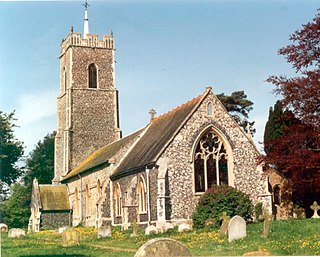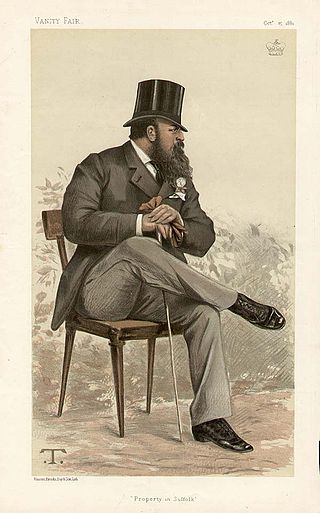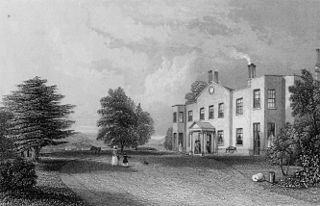
Rendlesham Hall was a large manor house in the village of Rendlesham in Suffolk.

Rendlesham Hall was a large manor house in the village of Rendlesham in Suffolk.
The hall was built in the pointed style in 1780 [1] and two lodges, Woodbridge Lodge and Ivy Lodge, were added in 1790. [2] The hall was acquired by Peter Thellusson, a wealthy banker, in the name of his son, in 1796. [3] The son, the 1st Lord Rendlesham, who went into politics as a Member of Parliament, occupied the hall. [3]
The hall was destroyed by fire in 1830 [3] and was rebuilt in Jacobean style to a design by William Burn. [3] The works, which were carried out by Lucas Brothers [4] were completed in 1870. [3] The new building had eight reception rooms, including a ballroom, a conservatory, twenty-five principal bedrooms with dressing rooms, nine secondary and thirteen servants' bedrooms, five bathrooms, eleven lavatories and extensive domestic offices. [3] There were 25 acres (10 ha) of grounds with tennis and croquet lawns, and a 4-acre (16,000 m2) walled kitchen garden in a park which extended to 250 acres (1.0 km2). [3]
The 5th Lord Rendlesham died in 1911, and the hall was put up for sale in 1920, but there were no bidders. [3] In 1923 the hall was sold for use as a sanatorium, in which use it remained until the Second World War, when it was occupied by the British Army. [3] For over 80 years the hall had played a major role in the social life of Suffolk, but after World War II it stood empty, and it was finally demolished in 1949. [3]

Pembroke College is a constituent college of the University of Cambridge, England. The college is the third-oldest college of the university and has over 700 students and fellows. It is one of the university's larger colleges, with buildings from almost every century since its founding, as well as extensive gardens. Its members are termed "Valencians". The college's current master is Chris Smith, Baron Smith of Finsbury.

Peterhouse is the oldest constituent college of the University of Cambridge in England, founded in 1284 by Hugh de Balsham, Bishop of Ely. Today, Peterhouse has 254 undergraduates, 116 full-time graduate students and 54 fellows. It is quite often erroneously referred to as Peterhouse College, although the correct name is simply Peterhouse.

Chatsworth House is a stately home in the Derbyshire Dales, 3.5 miles (5.6 km) north-east of Bakewell and 9 miles (14 km) west of Chesterfield, England. The seat of the Duke of Devonshire, it has belonged to the Cavendish family since 1549. It stands on the east bank of the River Derwent, across from hills between the Derwent and Wye valleys, amid parkland backed by wooded hills that rise to heather moorland. The house holds major collections of paintings, furniture, Old Master drawings, neoclassical sculptures and books. Chosen several times as Britain's favourite country house, it is a Grade I listed property from the 17th century, altered in the 18th and 19th centuries. In 2011–2012 it underwent a £14-million restoration. The owner is the Chatsworth House Trust, an independent charitable foundation, on behalf of the Cavendish family.

Belton House is a Grade I listed country house in the parish of Belton near Grantham in Lincolnshire, England, built between 1685 and 1687 by Sir John Brownlow, 3rd Baronet. It is surrounded by formal gardens and a series of avenues leading to follies within a larger wooded park. Belton has been described as a compilation of all that is finest of Carolean architecture, said to be the only truly vernacular style of architecture that England had produced since the Tudor period. It is considered to be a complete example of a typical English country house; the claim has even been made that Belton's principal façade was the inspiration for the modern British motorway signs which give directions to stately homes.

Wilton House is an English country house at Wilton near Salisbury in Wiltshire, which has been the country seat of the Earls of Pembroke for over 400 years. It was built on the site of the medieval Wilton Abbey. Following the dissolution of the monasteries, Henry VIII presented Wilton Abbey and its attached estates to William Herbert, 1st Earl of Pembroke.

Montacute House is a late Elizabethan mansion with a garden in Montacute, South Somerset.

Boscobel House is a Grade II* listed building in the parish of Boscobel in Shropshire. It has been, at various times, a farmhouse, a hunting lodge, and a holiday home; but it is most famous for its role in the escape of Charles II after the Battle of Worcester in 1651. Today it is managed by English Heritage.


Campsea Ashe is a village in Suffolk, England located approximately 5 miles (8 km) north east of Woodbridge and 6 miles (10 km) south west of Saxmundham.

Kentwell Hall is a stately home in Long Melford, Suffolk, England. It includes the hall, outbuildings, a rare-breeds farm and gardens. Most of the current building facade dates from the mid-16th century, but the origins of Kentwell are much earlier, with references in the Domesday Book of 1086.

Holkham Hall is an 18th-century country house near the village of Holkham, Norfolk, England, constructed in the Neo-Palladian style for the 1st Earl of Leicester by the architect William Kent, aided by Lord Burlington.

Shrubland Hall, Coddenham, Suffolk, is a historic English country house with planned gardens in Suffolk, England, built in the 1770s.

Frederick William Brook Thellusson, 5th Baron Rendlesham, was a British Conservative politician.

Sudbourne is a village and civil parish in Suffolk, England, located approximately 2 miles (3 km) north of Orford.

Goldsborough Hall is a Jacobean stately home located in the village of Goldsborough, North Yorkshire, England. It is a member of the Historic Houses Association. The house itself is a Grade II* listed building. The Hall was built for Sir Richard Hutton (1560–1639) after he acquired the Goldsborough Estate in 1598, and in the 20th century it was home to Princess Mary, Countess of Harewood as her first family home.
Chillesford is a village and civil parish in the East Suffolk district, in the English county of Suffolk. It is located on the B1084 road which runs east to west. Chillesford is 3 miles northwest of the small town of Orford. It is 5 miles southwest of Aldeburgh and 6 miles south of Saxmundham. Population of around 120 and 60 houses. At the 2011 Census the population is included in the civil parish of Butley
Sutton is a village and a civil parish on the B1083 road, in the East Suffolk district, in the county of Suffolk, England. Sutton has a pub, a mobile post office and a place of worship. There is also the hamlet of Sutton Street and the Sutton Common estate nearby.

Bentworth Hall is a country house in the parish of Bentworth in Hampshire, England. It is about 1 mile (1.6 km) south of Bentworth village centre and 4 miles (6.4 km) northwest of Alton, the nearest town.

Denbies is a large estate to the northwest of Dorking in Surrey, England. A farmhouse and surrounding land originally owned by John Denby was purchased in 1734 by Jonathan Tyers, the proprietor of Vauxhall Gardens in London, and converted into a weekend retreat. The house he built appears to have been of little architectural significance, but the Gothic garden he developed in the grounds on the theme of death achieved some notoriety, despite being short-lived. The estate was bought by Lord King of Ockham following Tyers's death in 1767, and the macabre artefacts he had installed, including two stone coffins topped by human skulls, were removed.

Burnham Westgate Hall is a Georgian country house near Burnham Market, Norfolk, about 2 mi (3.2 km) south of the north Norfolk coast. It was remodelled in Palladian style in the 1780s by John Soane: it was Soane's first substantial country house commission, immediately before he started Letton Hall in 1784.